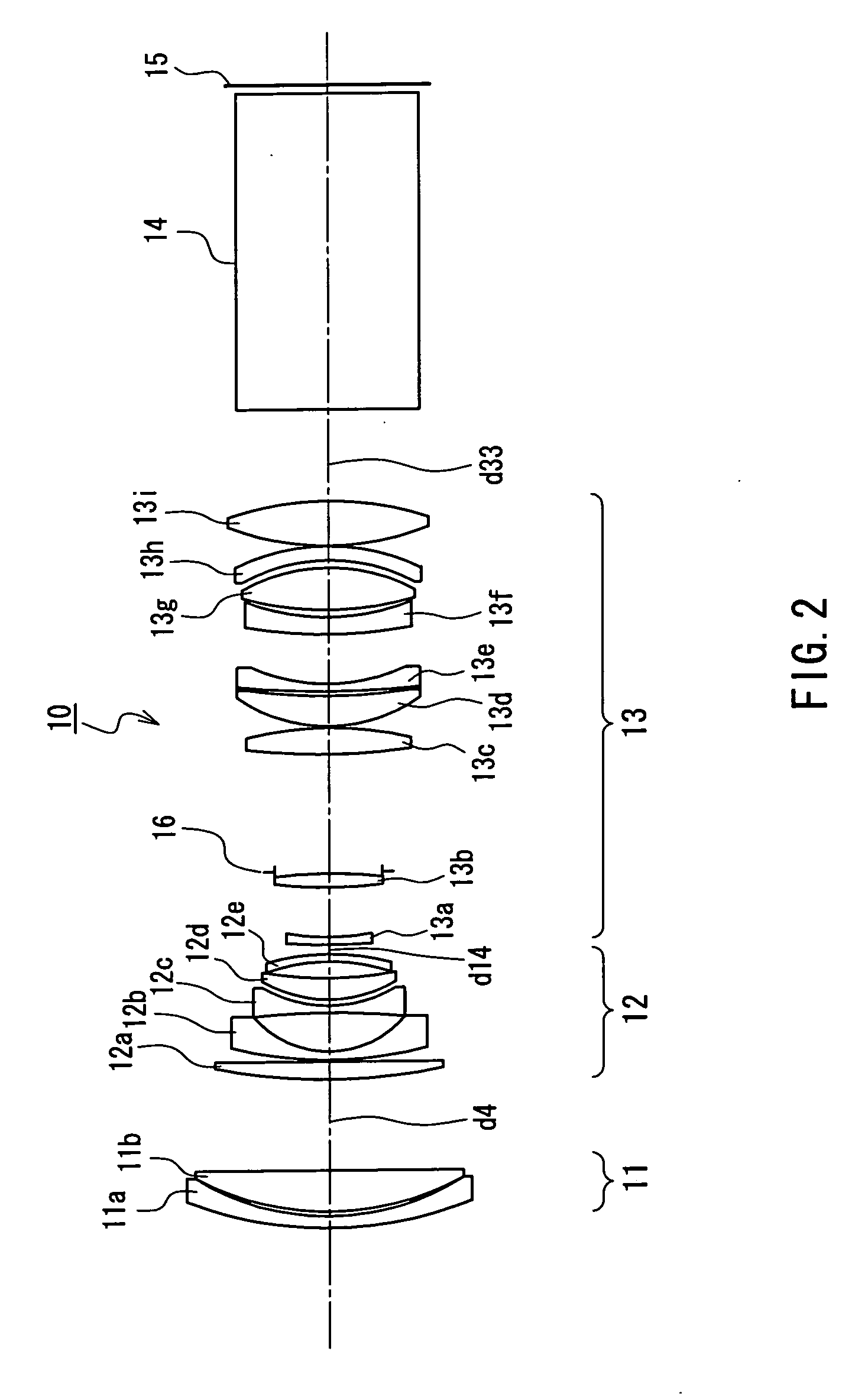Zoom lens, video enlarging/projecting system, video projector, rear projector, and multivision system
a multi-vision system and zoom lens technology, applied in the field of zoom lenses, can solve the problems of posing problems for miniaturization, affecting the quality of the image, so as to achieve good chromatic aberration, good chromatic aberration, and good chromatic aberration
- Summary
- Abstract
- Description
- Claims
- Application Information
AI Technical Summary
Benefits of technology
Problems solved by technology
Method used
Image
Examples
embodiment 1
[0130]FIG. 1 shows a view of a configuration of the wide angle end of a zoom lens according to Embodiment 1 of the present invention. FIG. 2 shows a view of a configuration of the telephoto end of the zoom lens shown in FIG. 1. A zoom lens 10 shown in FIG. 1 is provided with a first lens group 11 that has positive refractive power, a second lens group 12 that has negative refractive power, and a third lens group 13 that has positive refractive power, in the order as seen from the side with the longer conjugate distance. Numeral 14 denotes a glass block such as a prism. Numeral 15 denotes an image surface, and in the case of an image-taking system denotes film or CCDs, and in the case of a projection device, it denotes LCDs, for example, which are spatial modulating elements. In the figure, the side with the longer conjugate distance is the side that is opposite the image surface 15.
[0131] When changing magnification from the wide angle end (FIG. 1) to the telephoto end (FIG. 2), th...
working example 1
[0167] Working Example 1 according to Embodiment 1 is described below. The lens configuration of Working Example 1 is the same as the configuration in FIG. 1 and FIG. 2, and is a design example in which FNO=2.5 at the wide angle end, focal length f=37.08 and a half angle of view is 24.2°. The values of the above noted Expressions (1) to (12) in Working Example 1 are as follows:
f2g / f2top=−0.22 Expression (1)
frear / f2top=0.33 Expression (2)
(1 / f1 / abe1) / (1 / frear)=−0.01 Expression (3)
nd11=1.78472 Expression (4)
nd4=1.7725 Expression (5)
vd4=49.62 Expression (6)
f4r / bfw=1.08 Expression (7)
bfw / fw=2.07 Expression (8)
fw / f1g=0.16 Expression (9)
fw / f2g=−0.78 Expression (10)
fw / f3g=0.59 Expression (11)
|(DG1−DG3) / fw|=0.11 Expression (12)
[0168] Next, specific figures are shown in Table 1, and zoom data is shown in Table 2. In Table 1, ri (mm) is the radius of curvature of the lens surface, di (mm) is the lens thickness or the interval between lenses, ni is the refrac...
embodiment 2
[0171]FIG. 5 shows a view of a configuration of the wide angle end of a zoom lens according to Embodiment 2 of the present invention. FIG.6 shows a view of a configuration of the telephoto end of the zoom lens shown in FIG. 5. A zoom lens 20 shown in FIG. 5 is provided with a first lens group 21 that has positive refractive power, a second lens group 22 that has negative refractive power, and a third lens group 23 that has positive refractive power, in the order as seen from the side with the longer conjugate distance. The glass block 14, the image surface 15 and the aperture stop 16 are configured in the same way as in FIG. 1 and are provided with the same symbols, so their description is hereby omitted. In this drawing also, the side having the longer conjugate distance is the side opposite the image surface 15.
[0172] When changing magnification from the wide angle end (FIG. 5) to the telephoto end (FIG. 6), the first lens group 21 and the third lens group 23 move to the side hav...
PUM
 Login to View More
Login to View More Abstract
Description
Claims
Application Information
 Login to View More
Login to View More - R&D
- Intellectual Property
- Life Sciences
- Materials
- Tech Scout
- Unparalleled Data Quality
- Higher Quality Content
- 60% Fewer Hallucinations
Browse by: Latest US Patents, China's latest patents, Technical Efficacy Thesaurus, Application Domain, Technology Topic, Popular Technical Reports.
© 2025 PatSnap. All rights reserved.Legal|Privacy policy|Modern Slavery Act Transparency Statement|Sitemap|About US| Contact US: help@patsnap.com



